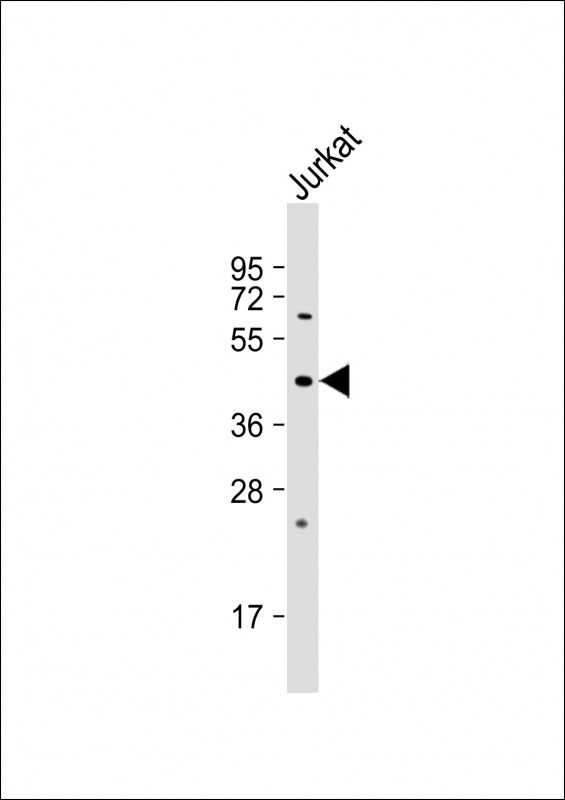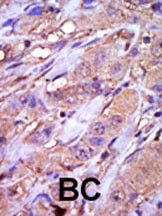CSNK1E Antibody (C-term)
Purified Rabbit Polyclonal Antibody (Pab)
- SPECIFICATION
- CITATIONS: 2
- PROTOCOLS
- BACKGROUND

Application
| IHC-P, WB, E |
|---|---|
| Primary Accession | P49674 |
| Reactivity | Human |
| Host | Rabbit |
| Clonality | Polyclonal |
| Isotype | Rabbit IgG |
| Calculated MW | 47315 Da |
| Antigen Region | 331-360 aa |
| Gene ID | 1454 |
|---|---|
| Other Names | Casein kinase I isoform epsilon, CKI-epsilon, CKIe, CSNK1E |
| Target/Specificity | This CSNK1E antibody is generated from rabbits immunized with a KLH conjugated synthetic peptide between 331-360 amino acids from the C-terminal region of human CSNK1E. |
| Dilution | IHC-P~~1:50~100 WB~~1:1000 E~~Use at an assay dependent concentration. |
| Format | Purified polyclonal antibody supplied in PBS with 0.09% (W/V) sodium azide. This antibody is prepared by Saturated Ammonium Sulfate (SAS) precipitation followed by dialysis against PBS. |
| Storage | Maintain refrigerated at 2-8°C for up to 2 weeks. For long term storage store at -20°C in small aliquots to prevent freeze-thaw cycles. |
| Precautions | CSNK1E Antibody (C-term) is for research use only and not for use in diagnostic or therapeutic procedures. |
| Name | CSNK1E |
|---|---|
| Function | Casein kinases are operationally defined by their preferential utilization of acidic proteins such as caseins as substrates (Probable). Participates in Wnt signaling (PubMed:12556519, PubMed:23413191). Phosphorylates DVL1 (PubMed:12556519). Phosphorylates DVL2 (PubMed:23413191). Phosphorylates NEDD9/HEF1 (By similarity). Central component of the circadian clock (PubMed:16790549). In balance with PP1, determines the circadian period length, through the regulation of the speed and rhythmicity of PER1 and PER2 phosphorylation (PubMed:15917222, PubMed:16790549). Controls PER1 and PER2 nuclear transport and degradation (By similarity). Inhibits cytokine-induced granuloytic differentiation (PubMed:15070676). |
| Cellular Location | Cytoplasm. Nucleus. |
| Tissue Location | Expressed in all tissues examined, including brain, heart, lung, liver, pancreas, kidney, placenta and skeletal muscle Expressed in monocytes and lymphocytes but not in granulocytes |

Provided below are standard protocols that you may find useful for product applications.
Background
CK1e is a serine/threonine protein kinase and a member of the casein kinase I protein family, whose members have been implicated in the control of cytoplasmic and nuclear processes, including DNA replication and repair. This protein is found in the cytoplasm as a monomer and can phosphorylate a variety of proteins, including itself. It has been shown to phosphorylate period, a circadian rhythm protein.
References
Hino, S., et al., J. Biol. Chem. 278(16):14066-14073 (2003). Eide, E.J., et al., J. Biol. Chem. 277(19):17248-17254 (2002). Keesler, G.A., et al., Neuroreport 11(5):951-955 (2000). Cegielska, A., et al., J. Biol. Chem. 273(3):1357-1364 (1998). Kloss, B., et al., Cell 94(1):97-107 (1998).
If you have used an Abcepta product and would like to share how it has performed, please click on the "Submit Review" button and provide the requested information. Our staff will examine and post your review and contact you if needed.
If you have any additional inquiries please email technical services at tech@abcepta.com.














 Foundational characteristics of cancer include proliferation, angiogenesis, migration, evasion of apoptosis, and cellular immortality. Find key markers for these cellular processes and antibodies to detect them.
Foundational characteristics of cancer include proliferation, angiogenesis, migration, evasion of apoptosis, and cellular immortality. Find key markers for these cellular processes and antibodies to detect them. The SUMOplot™ Analysis Program predicts and scores sumoylation sites in your protein. SUMOylation is a post-translational modification involved in various cellular processes, such as nuclear-cytosolic transport, transcriptional regulation, apoptosis, protein stability, response to stress, and progression through the cell cycle.
The SUMOplot™ Analysis Program predicts and scores sumoylation sites in your protein. SUMOylation is a post-translational modification involved in various cellular processes, such as nuclear-cytosolic transport, transcriptional regulation, apoptosis, protein stability, response to stress, and progression through the cell cycle. The Autophagy Receptor Motif Plotter predicts and scores autophagy receptor binding sites in your protein. Identifying proteins connected to this pathway is critical to understanding the role of autophagy in physiological as well as pathological processes such as development, differentiation, neurodegenerative diseases, stress, infection, and cancer.
The Autophagy Receptor Motif Plotter predicts and scores autophagy receptor binding sites in your protein. Identifying proteins connected to this pathway is critical to understanding the role of autophagy in physiological as well as pathological processes such as development, differentiation, neurodegenerative diseases, stress, infection, and cancer.


